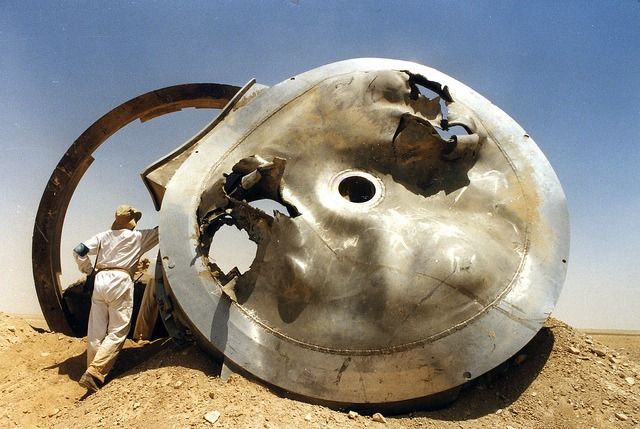Fulfilling the promise of the Trump-Kim Singapore summit
By James E. Goodby | July 18, 2018
 Iraq, 1991— UN/IAEA inspectors examine suspect equipment in Iraq following the 1991 Gulf War. Could inspections work in North Korea? (File photo, IAEA Imagebank.) Photo Credit: IAEA Action Team
Iraq, 1991— UN/IAEA inspectors examine suspect equipment in Iraq following the 1991 Gulf War. Could inspections work in North Korea? (File photo, IAEA Imagebank.) Photo Credit: IAEA Action Team
In spite of its slapdash execution and its many real problems—discussed in the pages of the Bulletin and elsewhere—let us not forget the bigger picture regarding the recent Singapore summit. The overarching goals laid out in the statement issued after the historic meeting between US President Trump and North Korean leader Kim Jong-un are realistic and highly desirable.
Of course, how we make vaguely outlined goals into tangible, specific, concrete realities is the sticking point. But based upon my experience as a US diplomat—with 35 years in the US Foreign Service and several assignments dealing with nuclear issues, including the START treaty and what became the Helsinki Accords—there is a rich menu of options for dealing with the present situation, drawing upon many different sources from the diplomatic, military, and political spectrum. When an issue has festered for years it attracts the interest of problem-solvers around the world, and that is certainly the case here. Experts of various persuasions, united only by their sense that there must be a way of solving the conundrum that is the Korean peninsula, have discussed and analyzed the situation, with a premium on getting things done quickly in a way that will reduce the nuclear danger to the world.
The proposals I have identified below all have the virtue of actions that could be started and, in some cases, put into operation very rapidly by diplomatic standards. Collectively, they could reduce the nuclear danger in the short term. They have the potential for setting in motion a program and a process that would achieve the goals set out after the Trump-Kim meeting.
They consist of four elements which I think are essential to getting started on denuclearization of the Korean Peninsula, along with several items vital to maintaining the momentum and sustainability of such a process once it gets started.
Where to begin. To make a start on denuclearization in Korea, four interlinked elements will be essential. While they cannot all be completed in one year, they could be started easily within that time frame, and by doing so would put North Korea at least on the path towards elimination of nuclear weapons.
First, there needs to be a meaningful step taken by North Korea to assure the West that the freeze on missile and nuclear weapons tests is real and will continue. This could be accomplished by an invitation by Pyongyang to the United States and South Korea to send inspectors to all known test sites immediately, and agreeing to a small number of challenge inspections annually thereafter. In return, the United States and South Korea would accept challenge inspections at bases in South Korea that have historically been involved in large-scale, US-South Korea joint exercises.
Second, North Korea and the United States must agree to begin a study on how to make nuclear warhead dismantlement transparent and irreversible. There is precedent for such a study, in work carried out by the United States and Russia in 1994-95. It is not a fanciful or impractical goal, and there are well-defined techniques for monitoring it.
Third, North Korea needs to agree that while this study is going on, it will not deploy nuclear warheads. (By “deployed,” I refer to warheads mated with nuclear delivery systems, which is how the term was defined for the purposes of the US-Russia Strategic Offensive Reductions Treaty of 2002.)
Fourth, both North and South Korea would agree to work for a nuclear-weapons-free zone in Northeast Asia. The zone could include their own territories, which the United States would pledge to honor. Japan might agree to continue its present policy of neither acquiring nuclear weapons nor accepting nuclear weapons on its territory. An important contribution to this zone could be made by China and Russia, both of which deploy intermediate-range weapons within range of all of the Korean Peninsula and Japan. To strengthen a nuclear-free zone in Northeast Asia, China and Russia could re-deploy these nuclear systems so that they would be out of range of Japan and Korea—analogous to the United States’ vowing not to deploy nuclear weapons on the Korean Peninsula. China’s DF- 21 and Russia’s SS-21 missile (now being replaced with the SS-26) would be candidates for such redeployment.
Would all this activity guarantee that all North Korean nuclear weapons would be eliminated within some predictable period of time? Of course not.
But collectively these steps would put North Korea and nations that support the idea of eliminating nuclear danger on a clear path towards this goal, while enhancing stability in the region and bringing greater safety to the world at large.
How to sustain momentum and sustainability. It has been clear for a long time that nuclear reductions may not be possible and will certainly not be sustainable if political changes do not accompany them. In Northeast Asia this truism has two implications: The left-over disputes and mistrust of the Korean War must be resolved promptly, and a multilateral mechanism to promote security and cooperation in the region should be established, soon. Fortunately, a great deal of work has been done on these diplomatic tasks over the years and a fair amount of consensus may already exist. It may be summed up as follows:
The Korean War Armistice Agreement of 1953 should be replaced with a full-fledged, formal agreement. That agreement among the United States, China, and North and South Korea would need to define borders between the two parts of Korea, provide for rapid means of communication between the parties, establish consultative mechanisms, and perhaps limit military deployments. Other nations involved in the war—and the United Nations—should join in extending guarantees. This need not be a peace treaty at the outset but it could become one.
North and South Korea should create a peace regime between them. The best example of what the provisions of a peace regime would look like already exists in the Basic Agreement between the two parts of Korea. This agreement was concluded in 1992 but rising tensions at the time meant that it was never really implemented. The Agreement has some features that resemble the Helsinki Final Act of 1975 which defined the principles of the international order in Europe at the end of the Cold War. For example, the Basic Agreement calls for military confidence-building measures and freer movement of people, information, and ideas. With minimal changes, this agreement could be revived and put into force.
A mechanism for security and cooperation in Northeast Asia must be put in place. This option has been discussed for years, including whether its form might use the Conference on Security and Cooperation in Europe as a sort of rough template, while endowing it with characteristics reflecting conditions existing in Northeast Asia. Enough thought has been given to this concept to make it possible to begin the negotiations necessary to start the process in the near future. The idea is to have a forum that can consult at various levels about issues that have region-wide implications for peace, stability, and cooperation. If North Korea decided to join this forum it could expedite the integration of that country into the regional and global economy. It might even enhance the prospects for reunification of North and South Korea.
Together, we make the world safer.
The Bulletin elevates expert voices above the noise. But as an independent nonprofit organization, our operations depend on the support of readers like you. Help us continue to deliver quality journalism that holds leaders accountable. Your support of our work at any level is important. In return, we promise our coverage will be understandable, influential, vigilant, solution-oriented, and fair-minded. Together we can make a difference.
Keywords: North Korea, North Korea summit, Singapore Summit, denuclearization
Topics: Analysis, Nuclear Risk, Nuclear Weapons















